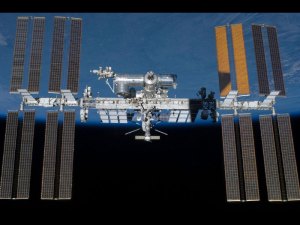International Space Station gets extension

The International Space Station --NASA image.
The Obama administration's decision to keep the station in orbit will provide commercial space market opportunities, advance scientific research and help NASA prepare for deep-space exploration, agency spokesmen said during a press conference.
The extension also keeps in orbit NASA’s signature spacecraft at a time when China’s moon mission is making headlines. It cements “continuing U.S. leadership in human spaceflight going forward,” according to a blog post by Charles Bolden, NASA administrator, and John Holdren, director of the White House Office of Science and Technology Policy.
The space station’s budget is $3 billion a year. Asked if Congress could still pull the plug on the extension, a NASA spokesman said the agency is confident political support for the space station will continue.
So what are the benefits of keeping the space station circling? NASA officials made their case:
The extension also keeps in orbit NASA’s signature spacecraft at a time when China’s moon mission is making headlines. It cements “continuing U.S. leadership in human spaceflight going forward,” according to a blog post by Charles Bolden, NASA administrator, and John Holdren, director of the White House Office of Science and Technology Policy.
The space station’s budget is $3 billion a year. Asked if Congress could still pull the plug on the extension, a NASA spokesman said the agency is confident political support for the space station will continue.
So what are the benefits of keeping the space station circling? NASA officials made their case:
- Benefits to humanity. “We are starting to see a lot of benefits on the space station that have direct applications to folks here on the Earth,” said Bill Gerstenmaier, associate administrator for NASA's Human Exploration and Operations Mission Directorate. He mentioned specifically pharmaceutical and climate change research. It takes three to four years to get a research project ready for the space station, Gerstenmaier added. If the space station were to stop operating in 2020, that wouldn’t give researchers much time to work.
- More study on the impact of long-term spaceflight. ”We talk about going beyond low-Earth orbit, extending human presence out to distances -- Mars. We have a lot to learn,” Gerstenmaier said. “We need more experiments to look at how the human body actually adapts to microgravity for significant periods.”
- Increased proficiency in handling problems with the spacecraft. In early December, a pump on the space station malfunctioned. Astronauts performed two spacewalks to fix the faulty equipment just before Christmas. “There [are] a lot of systems in space that we really need to test,” Gerstenmaier said. It’s one thing to test equipment in low-Earth orbit. "When we commit to distances as far as Mars, we better have that system really understood. ... We don’t have an option to go pull things back and do things.”
- Increased commercial opportunities. The extension allows time for the commercial space industry to begin transporting cargo and crew to low-Earth orbit, “allowing NASA to continue to increase its focus on developing the next-generation heavy-lift rocket and crew capsule necessary for deep-space exploration,” Bolden and Holdren wrote in their blog. Private companies could transport crews to the station as early as 2017.
Related:
NASA TV to air Orbital Sciences mission to International Space Station
NASA video offers highlights of Dec. 21 spacewalk

